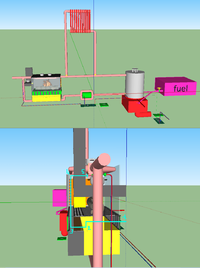No edit summary Tag: n |
No edit summary |
||
| Line 1: | Line 1: | ||
[[File:Wood_fueled_space_heating_system.png|thumb|right|200px|The AT CAD Team's Wood fueled space heating system shows one possible way how to tune your space heating system: by swapping the burner with a stove]] | [[File:Wood_fueled_space_heating_system.png|thumb|right|200px|The AT CAD Team's Wood fueled space heating system shows one possible way how to tune your space heating system: by swapping the burner with a stove]] | ||
The space heating system is one of the largest GHG-emitting sources we have in our house. In order to reduce the amount of GHG emitted, aswell as increase the efficiency of the system/reduce operating cost, there are several | The [[Space heating|space heating system]] is one of the largest GHG-emitting sources we have in our house. In order to reduce the amount of GHG emitted, aswell as increase the efficiency of the system/reduce operating cost, there are several modifications we can do, depending on the type of space heating system you currently have/use. | ||
== | ==Central heating systems== | ||
If you use radiators heated by a burner operating on fossil fuel, you can: | If you use radiators heated by a burner operating on fossil fuel, you can: | ||
* change the fuel you use (ie natural gas, fuel oil, ...) to a [[biofuel]] (ie straight vegetable oil, ...) | * change the fuel you use (ie natural gas, fuel oil, ...) to a [[biofuel]] (ie straight vegetable oil, ...) | ||
Revision as of 13:25, 18 March 2013

The space heating system is one of the largest GHG-emitting sources we have in our house. In order to reduce the amount of GHG emitted, aswell as increase the efficiency of the system/reduce operating cost, there are several modifications we can do, depending on the type of space heating system you currently have/use.
Central heating systems
If you use radiators heated by a burner operating on fossil fuel, you can:
- change the fuel you use (ie natural gas, fuel oil, ...) to a biofuel (ie straight vegetable oil, ...)
- use your existing fireplace, or implement a new fireplace/stove (which burns wood) to heat your radiators. This can be done using a heat exchanger. This is a cost-effective option (wood being cheap) which reduces your emissions considerably. The downside however is that you need to start your fire manually every time. You also can not use your old fuel-powered heater.
- replace the fuel-powered heater with a electrical heater. This is economically the least intresting option, yet reduces GHG emissions of this appliance to 0[1]
References and footnotes
External links
- http://en.wikipedia.org/wiki/Radiator#Conventional_radiators
- http://en.wikipedia.org/wiki/Water_heating
- ↑ Atleast when using "green power" from the electricity companies